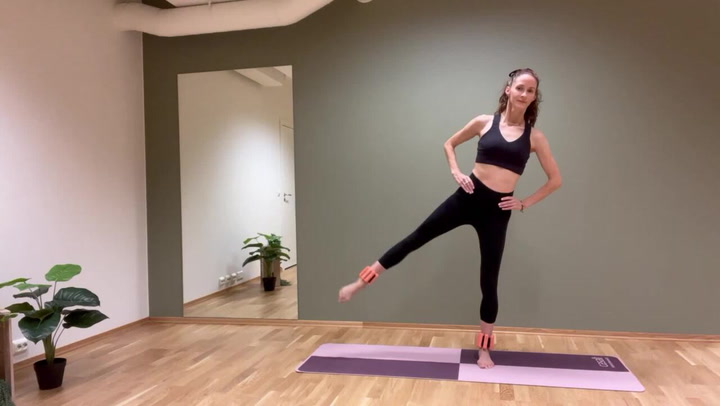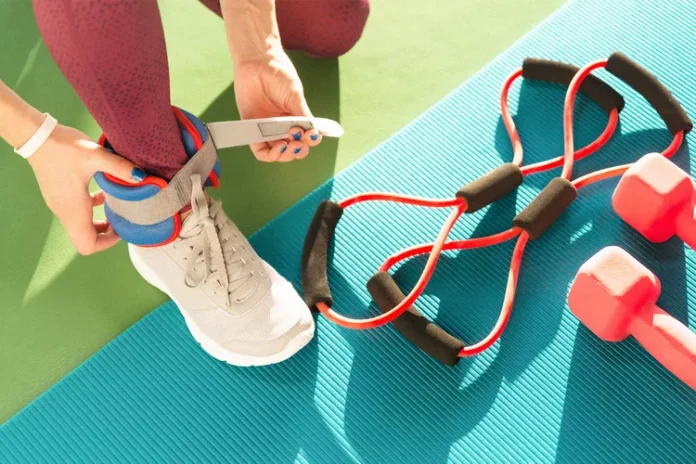Maybe you wrote off ankle weights as an old-school ’80s fitness trend that faded out alongside working out with permed hair and elastic sweatbands. But unlike those relics of the past, ankle weights have proven to have staying power in today’s workouts — in fact, modern ankle weights are popping up everywhere, from hot girl walks to low-impact barre workouts.
But how exactly do you use ankle weights, and do ankle weights actually work? Here, experts explain the benefits of ankle weights, plus how to do ankle weight exercises properly.
The Benefits of Ankle Weights
The number one benefit of ankle weights is that they add more resistance to your workout, says Lauren Leavell, a NASM-certified personal trainer and corrective exercise specialist. “Ankle weights add resistance to your training by adding extra weight, so your muscles get stronger because you’re activating them in a different way,” she explains.
And no matter where you are in your fitness journey, using ankle weights can improve your overall stamina and strength, says Emilie Goldblum, an intuitive stretch movement body coach and former Olympic rhythmic gymnast. “Having a set of [ankle weights] is great for anybody looking to elevate their fitness routine, even just by wearing them around the house with your kids, going to the grocery store, or taking a walk with ankle weights,” she says.
In addition to the extra resistance, here are a few other benefits to working out with ankle weights.
Ankle weights are extremely versatile.
Similar to wrist weights, a major benefit of ankle weights is that they’re highly versatile. You can bring them anywhere, strap them to your ankles while traveling or taking a walk, and use them at your feet or in your hands as weights if you’re stuck at a gym-less hotel, says Holly Perkins, C.S.C.S., author of Lift to Get Lean. One you’ll want to be mindful of is to avoid actually wearing ankle weights on your wrists. Ankle weights are larger than wrist weights, so they’d be prone to slipping on your wrists and would need frequent adjustment, as Shape previously reported.
Also, ankle weights can be used for different levels of exercise, adds Leavell. “Whether you’re seated, in tabletop position, or standing, ankle weights can really be adjusted to the level of workout that you’re looking for,” she says.
Ankle weight exercises can target and isolate muscle groups.
When used correctly, ankle weight exercises can also work muscles that have grown weak from inactivity. For example, if you spend most of your day working at a desk, you might develop glute amnesia — a real postural issue that stems from weak glutes. Ankle weights can be useful in a physical therapy setting, too — say if you’re suffering from a lower-body ailment such as injured or weak hamstrings or knee issues, notes Perkins.
How to Activate Underused Glutes (Because Yours Are Probably Sleeping)
And as a side perk: Using ankle weights to isolate certain muscle groups can make you more mindful of your form during your workout, says Leavell. “Having a weight at the end of your leg draws your attention down your leg toward your ankle,” which could be helpful in maintaining proper form and feeling your movements differently than bodyweight-only exercises, she explains.
Ankle weights can help increase bone density.
As with any strength workout, working out with ankle weights can help increase bone density. And having stronger bones is a key factor in preventing osteoporosis, a disease that causes bones to become weak and break easily and affects women disproportionately more than men (case in point: of the estimated 10 million people with osteoporosis, more than 8 million are women). “It’s important for women specifically to do some light weight-bearing exercises as a preventative measure to osteoporosis,” Goldblum says. “Resistance exercises are the best types of workouts to help improve bone mass and strength,” since working out with resistance (such as ankle weights) improves bone mass density and reduces the risk of fractures.
Even simply walking with ankle weights can improve your strength and overall health, as research shows that walking with resistance can improve skeletal muscle percentage (reminder: skeletal muscles are the voluntary muscles that are connected to your bones throughout your body). Wearing ankle weights when walking can add impact forces, which may help with maintaining bone density, says Michele Olson, Ph.D., an exercise physiologist and senior clinical professor at Huntingdon College in Montgomery, Alabama.
Ankle weights let you move more freely than traditional dumbbells.
Another big benefitof ankle weights? Ankle weights allow you to move freely and perform movements you can’t with traditional weight equipment. (Have you ever tried doing a donkey kick with a dumbbell? Case in point.) “Ankle weights allow you to move in nearly every direction and rotation imaginable,” says Perkins. This is particularly important for hip work. “The hip is a ‘ball joint’ that moves in all directions. It’s important to strengthen the numerous movement patterns and large and small muscles that are at play,” she explains.
Why Controlled Articular Rotations Should Be a Part of Your Mobility Routine
How to Use Ankle Weights
Before adding ankle weights to your routine, make sure you feel confident in your form for any exercise you plan to use with ankle weights, urges Goldblum. “Initially you want to do the [ankle weights exercises] first, without any extra resistance,” she says. “Then add the ankle weights once you’re comfortable with the exercises,” as long as you’re not experiencing any discomfort during your workout with ankle weights. Remember to maintain proper form throughout any movements, whether that means avoiding an overarched back or engaging your core.
Here are other tips from experts to keep in mind for your next ankle weights workout.
Choose the appropriate ankle weight for your workout.
First things first when learning how to use ankle weights: Make sure you’re using the right weight load for the intended exercise. If you’re walking with ankle weights, keep them light — three to five pounds max. Any more weight can alter your stride, placing stress on your low back and pelvis, says Olson.
For specific exercises (such as the aforementioned donkey kick), you can use up to five- to 10-pound weights on each leg, but the best ankle weight varies for everyone. “The perfect weight load for any exercise is one where the last two reps of every set are really hard to complete,” says Perkins.
Interested in exercising with ankle weights? Pick up a set (such as these from Amazon: Buy It, $18, amazon.com) and secure them around your ankles for these three exercises, as demonstrated by Perkins in her Instagram video below.
Talk to your doctor before using ankle weights.
As with any new fitness routine, you should ideally get sign-off from your doctor or another medical expert before starting a regular ankle weights workout routine. “I advise students to check in with their health practitioner before starting anything new for the most specific and up-to-date medical advice aimed specifically for their optimal health,” says Goldblum.
Gradually add ankle weights into your workout routine.
Once you’re confident in bodyweight-only exercises, you’re cleared to start working out with ankle weights in small doses. But instead of strapping ankle weights to your feet 24/7, gradually build up your ankle weight exercises over time, advises Goldblum. “I would recommend starting gently, consistently, and doing low-impact exercises — such as going for a 20-minute walk with one-pound ankle weights to start,” says Goldblum.
Low-impact workout modalities, such as barre and Pilates, are especially well-suited for ankle weights, says Leavell. “With slow, really controlled and concentrated movements, just adding that extra piece of resistance can completely change your practice,” she says. Eventually, you can work up to wearing your ankle weights a few times a week for low-impact-style exercise.
The 5 Best Ankle Weights Exercises
To help you get the most out of your ankle weights, Goldblum, a BALA ambassador, recommends this set of exercises. Make sure your weights are strapped securely around your ankles for a snug (but not overly tight) fit — that way, you’re not distracted by them slipping during your workout.
Standing Leg Extension

A. Stand with your feet hip-width apart, balancing on your right foot with your left leg bent at 90-degrees and left toes pointed. Place hands on hips or against a wall for easier balance.
B. Extend left leg behind you with toes pointed until you feel a gentle stretch in hip flexor. Squeeze hamstring and glute at full extension. Avoid overarching low back or lifting left leg higher than is comfortable.
C. Bend left knee and return to starting position, engaging core to lift knee. For a modification, ball of left foot lightly touches the ground in between reps. Repeat on both legs.
Standing Abductors

A. Stand with feet hip-width apart and hands on hips, toes pointing forward.
B. Bend right knee to bring right foot in line with left ankle or left knee.
C. Extend right leg straight out to your right side as you squeeze and lift with outer leg and glutes.
D. Lower right leg with control and return to starting position with right knee bent. For a modification, ball of right foot lightly touches the ground in between reps. Repeat on both legs.
Three-Legged Dog to Single-Leg Plank

A. Begin in downward dog: Start on all fours in a tabletop position. Lift hips up and back, gently straightening legs to move into downward dog.
B. On an inhale, extend left leg back up toward the ceiling by shifting shoulders back and squeezing glutes. Hands stay in place on the mat.
C. On an exhale, pull torso and shoulders forward into high plank on right leg only; shoulders stacked over wrists and hips square to the ground. Engage core and imagine pushing the floor away to prevent shoulders from sinking into shoulder joints. For a modification, left foot lightly touches the ground in between reps. Repeat on both legs.
Donkey Leg Kicks

A. Start in tabletop position with shoulders stacked over wrists and hips stacked over knee.
B. Maintaining the 90-degree bend in left knee, lift left knee up until it’s in line with left hip; sole of left foot should face the ceiling.
C. Lift left leg one inch, squeezing glutes and engaging core to avoid opening up toward left side.
D. Lower left leg one inch with control. Imagine rotating inner left thigh in and up to the ceiling to engage hamstrings. Repeat on both legs.
Total Body Ankle Weight Complex

A. Begin in a variation of tabletop position, with hands on the mat slightly in front of your shoulders.
B. On an inhale, extend left leg straight back and press your hips away from your shoulders; the result should be similar to a modified three-legged dog.
C. On an exhale, shift forward while bending left leg forward and toward left elbow. Bend arms slightly for a half modified push-up.
D. Extend left leg back out to repeat the movement. Repeat on both sides.


